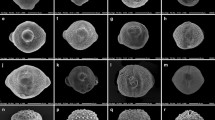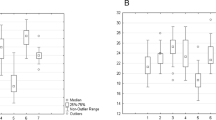Abstract
The pollen morphological variation in the families of the Ranunculiflorae (Berberidaceae, Fumariaceae, Lardizabalaceae Menispermaceae Nelumbonaceae, Papaveraceae and Ranunculaceae) is summarised and discussed in relation to the systematics of the group. The pollen grains are generally dispersed as monads, but permanent tetrads occur in a few instances. Aperture numbers range from one, in spiraperturate pollen of Berberis and some species of Anemone and in the rare monosulcate grains that occur in some individuals of Nelumbo, to three in the majority of species, to many. These tricolpate-derived forms range from zonocolpate to pantocolpate and pantoporate forms. With the exception of some Papaver species, the occurrence of endoapertures appears restricted to Menispermaceae, where they are generally present. The ornamentation is generally punctate to microreticulate, often with spinules or striate to striate-reticulate. The exine stratification is generally tectate-columellate, with a granular infratectum in some taxa, and the endexine is well developed. Pollen grains of Ranunculiflorae exhibit successiformy and spiralization, two of the evolutionary patterns that were first recognised and defined by Van Campo (1967, 1976). These pollen morphological patterns result in a high level of homoplasy (similarity arising through convergent or parallel evolution). Many of the palynological characters are autapomorphic and thus serve to identify distinctive taxa (such as Berberis or Fumaria). Fewer characters can clearly be recognised as synapomorphies at the familial or subfamilial level, especially in the absence of a detailed character analysis integrating palynological and other kinds of evidence. One potentially important character that may not be subject to extensive homoplasy is the occurrence of a compound layer of striae (sensu Nowicke & Skvarla 1982) in contrast to psilate, punctate or microreticulate ornamentation with scabrae or microechinae.
Access this chapter
Tax calculation will be finalised at checkout
Purchases are for personal use only
Preview
Unable to display preview. Download preview PDF.
Similar content being viewed by others
References
Agabavian, V. C., 1973: Pollen of primitive angiosperms. — Erevan Bot. Inst. Akad. Nauk. Armenia SSR.
Al-Eisawi, D., 1986: Pollen morphology of Ranunculaceae in Jordan. — Pollen & Spores 28: 311–328.
Archangelsky, D. B., 1973: Palynological taxonomy of Berberidaceae.-In Kuprianova, L. A. (Ed.): Pollen and spore morphology of recent plants, pp. 18–21 — Leningrad: Nauka.
Belmonte, J., Perez-Obiol, R., Roure, J. M., 1986: Clavas para la determinación de los pólenes de las principales especies meliferas de la Peninsula Iberica. — Orsis 2: 27–54.
Blackmore, S., Heath, G. L. A., 1984: Berberidaceae. Northwest European pollen flora 30. — Rev. Palaeobot. Palynol. 42: 7–21.
— Barnes, S. H., 1995: Garside’s rule and the microspore tetrads of Grevillea rosmarinifolia A. cunn. and Dryandra polycephala Benth. (Proteaceae). Rev. Palaeobot. Palynol. 85: 111–121.
Candau, P., Soler, A., 1981: Contribucion à la palinologia de la familia Fumariaceae en la Peninsula Iberica. — Bot. Macaronesica 8–9: 147–162.
— Fernandez-Paniagua, I., 1985: Polen en Papaveraceae de Andalucia occidental. — Anal. Asoc. Palinol. Leng. Espan. 2: 25–34.
Chang, K. T., Wang, P. L., 1983: Study on the pollen morphology of the family Berberidaceae. — Acta Phytotax. Sinica 21: 130–142.
Clark, C., 1978: Pollen shed as tetrads by plants of Eschscholzia californica (Papaveraceae). — Madroño 25: 59–60.
Clarke, G. C. S., Punt, W., Hoen, P. P., 1991: Ranunculaceae. Northwest European pollen flora 51. — Rev. Palaeobot. Palynol. 69: 117–271.
D’arcy Thompson, W., 1917: Growth and form. — Cambridge: Cambridge University Press.
Erdtman, G., 1952: Pollen morphology and plant taxonomy — Angiosperms. Stockholm: Almqvist Wiksell.
— 1960: The acetolysis method, a revised description. — Svensk Bot. Tidskr. 54: 561–564.
Ferguson, I. K., 1975: Pollen morphology of the trible Triclisieae of the — Menispermaceae in relation to its taxonomy. — Kew Bull. 30: 49–75.
— 1978: Pollen morphology of the tribe Coscinieae of the Menispermaceae in relation to its taxonomy. — Kew Bull. 32: 339–346.
Fernandez, I., 1985: Morfologia polinica de Ranunculus arvensis L. — Anal. Asoc. — Palinol. Leng. Espan. 2: 19–23.
— 1986: Contribucion al conocimiento palinologico de la familia Ranunculaceae en Andalucia: 1. Subf. Helleboroideae. — Lagascalia 14: 13–23.
Harley, M. M., Ferguson, I. K., 1982: Pollen morphology and taxonomy of the tribe Menispermeae (Menispermaceae). — Kew Bull. 37: 353–366.
Henderson, D. M., 1965: The pollen morphology of Meconopsis. — Grana Palynol. 6: 291–209.
Heslop-Harrison, J., 1966: Cytoplasmic continuities during spore formation in flowering plants. — Endeavour 25: 65–72.
Heusser, C. J., 1971: Pollen and spores of Chile. — Tucson: University of Arizona Press.
Huang, T. C., 1972: Pollen flora of Taiwan. — Taipei National Taiwan University of Botany Press.
Huynh, K.-L., 1970: Le pollen de genre Anemone et du genre Hepatica (Ranunculaceae) et leur taxonomi. — Pollen Spores 12: 329–364.
— 1976: Arrangement of some monosulcate, disulcate, dicolpate and tricolpate pollen types in the tetrads, and some aspects of evolution in angiosperms. — In Ferguson, I. K., Muller, J., (Eds): The evolutionary significance of the exine. — Linn. Soc. Symp. Ser. 1: 101–124.
Ikuse, M., 1956: Pollen grains of Japan. — Tokyo: Hirokawa.
Kalis, A. J., 1979: Papaveraceae. Northwest European pollen flora.-Rev. Palaeobot. Palynol. 28: 209–260.
Kubitzki, K., 1993: Some aspects of the classification and evolution of higher taxa. In Kubitzki, K., Rohwer, J. G., Bittrich, V., (Eds): The families and genera of vascular plants. II: Flowering plants — dicotyledons: magnoliid, hamamelid and caryophilid families. — Berlin: Springer.
Kumazawa, M., 1936: Pollen grain morphology in Ranunculaceae, Lardizabalaceae, and Berberidaceae. — Japan. J. Bot. 8: 19–46.
Kuprianova, L. A., 1979: On the possibility of the development of tricolpate pollen from monosulcate. — Grana 18: 1–4.
Layka, S., 1976: Le polymorphisme pollinique dans le genre Argentone (Papaveraceae).-Pollen & Spores 18: 351–375.
— 1977: Les caractéres de l’endexine chez les Papaveracees. — Bull. Soc. Bot. Franco 122: 103–107.
Lee, S., Blackmore, S., 1992: Pollen morphology in the genus Trollius (Ranunculaceae). — Grana 31: 81–100.
Nowicke, J. W., Skarvla, J. J., 1980: Pollen morphology: the potential influence in higher order systematics. — Ann. Missouri Bot. Gard. 66: 633–700.
— 1981: Pollen morphology and phylogenetic relationships of the Berberidaceae. — Smithsonian Contrib. Bot. 50: 1–83.
— 1982: Pollen morphology and the relationships of Circaeaster, of Kingdonia and of Sargentodoxa to the Ranunculales. — Amer. J. Bot. 69: 990–998.
— 1983: A palynological study of the genus Helleborus (Ranunculaceae). — Grana 22: 129–140.
Rachele, L. D., 1974: Pollen morphology of the Papaveraceae of the northeastern United States and Canda. — Bull. Torrey Bot. Club 101: 152–159.
Roland-Heydacker, F., 1974: Caractéres ultrastructuraux et cytochimiques particuliers du sporoderme des polen de Berberis vulgaris L. et de Mahonia aquifolium Nutt. — Compt. Rend. Acad. Sci. Paris 278: 1475–1477.
Santisuk, T., 1979: A palynological study of the tribe Ranunculeae. — Opera Bot. 48: 1–74.
Scotland, R., 1993: Pollen morphology of Contortae (Acanthaceae). — Bot. J. Linn. Soc. 111: 471–504.
Stern, K. R., 1962: The use of pollen morphology in the taxonomy of Dicentra. — Amer. J. Bot. 49: 362–368.
Thanikaimoni, G., 1968: Morphologie des pollens des Menispermacees. — Inst. Fr. Pondichery, Trav. Sect. Sci. Tech. 5: 1–57.
— 1984: Menispermacees: palynologie et systematique. — Inst. Fr. Pondichery, Trav. Sect. Sci. Tech. 18: 1–135.
Van Campo, M., 1967: Pollen et classification. — Rev. Palaeobot. Palynol. 3: 65–71.
— 1976: Patterns of pollen morphological variation within taxa.-In Ferguson, I. K., Muller, J., (Eds): The evolutionary significance of the exine. — Linn. Soc. Symp. Ser. 1: 125–137.
— 1978: Phylogenie des angiospermes. Approche palynologique. — Mem. Trav. Inst. Ecole Practique des Hautes Etudes Montpellier 4: 73–90.
Walker, J. W., 1976: Evolutionary significance of the exine. — In Ferguson, I. K., Muller, J., (Eds): The evolutionary significance of the exine. — Linn. Soc. Symp. Ser. 1: 251–308.
— Doyle, J. A., 1975: The bases of angiosperm phylogeny: palynology. — Ann. Missour Bot. Garden 62: 644–723.
Wodehouse, R., 1935: Pollen grains: their structure, identification and significance in science and medicine. — New York: McGraw-Hill.
Xia, Q., Peng, Z. X., 1989: A study on the pollen morphology of Lardizabalaceae, Sargen-todoxaceae and its significance in taxonomy. — Bull. Bot. Res. North-East. Forest. Inst. 9: 99–114.
Author information
Authors and Affiliations
Editor information
Editors and Affiliations
Rights and permissions
Copyright information
© 1995 Springer-Verlag Wien
About this paper
Cite this paper
Blackmore, S., Stafford, P., Persson, V. (1995). Palynology and systematics of Ranunculiflorae . In: Jensen, U., Kadereit, J.W. (eds) Systematics and Evolution of the Ranunculiflorae. Plant Systematics and Evolution Supplement 9, vol 9. Springer, Vienna. https://doi.org/10.1007/978-3-7091-6612-3_7
Download citation
DOI: https://doi.org/10.1007/978-3-7091-6612-3_7
Publisher Name: Springer, Vienna
Print ISBN: 978-3-7091-7361-9
Online ISBN: 978-3-7091-6612-3
eBook Packages: Springer Book Archive




